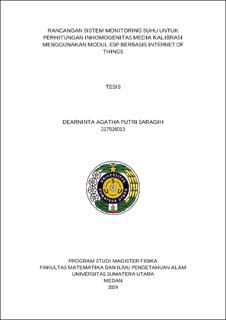Rancangan Sistem Monitoring Suhu untuk Perhitungan Inhomogenitas Media Kalibrasi Menggunakan Modul ESP Berbasis Internet of Things
A Design of Monitoring Temperature System for The Determination of Calibrated Inhomogeneity Media via ESP Modules Based on Internet of Things

Date
2024Author
Saragih, Dearninta Agatha Putri
Advisor(s)
Tarigan, Kerista
Humaidi, Syahrul
Metadata
Show full item recordAbstract
BMKG has established a Calibration Laboratory that is certified by ISO/IEC 17025:2017. Compliance with this standard certification necessitates frequent calibration to uphold the accuracy of data and measurements. An important factor that can impact the accuracy of calibrated measurements is the inhomogeneity of the calibrating media, which can lead to temperature fluctuations and instability. The primary calibrating medium utilized by BMKG is an air chamber equipped with a temperature controller. The purpose of this study is to develop a temperature monitoring system based on the Internet of Things (IoT) by employing ESP32 Modules and 9 DHT22 sensors, controlled by C++ Arduino Mega, to automatically assess temperature disparities within the chamber. The recorded temperatures are subsequently compared to standardized laboratory measurements. Our findings revealed that the detected temperature disparities amounted to 0.9°C, aligning precisely with the results obtained from the accredited calibrated laboratory. The system measures the temperature disparities at 0°C, as opposed to the 2°C accounted for by the standardized system, with both sensors strategically positioned in the same location, specifically the left-upper corner at the rear of the chamber, following the Technical Guidelines outlined in the Calibration Laboratory Documents. This developed system effectively monitors real-time temperatures through an IoT platform, ThinkSpeak, with data collection occurring every 20 seconds, a significant improvement compared to the 30-minute interval of the standard system. Consequently, the time required to calculate temperature disparities can be reduced by a factor of 90.
Collections
- Master Theses [310]
